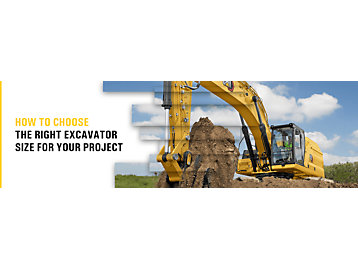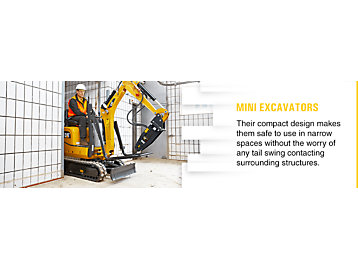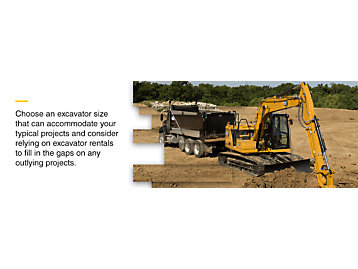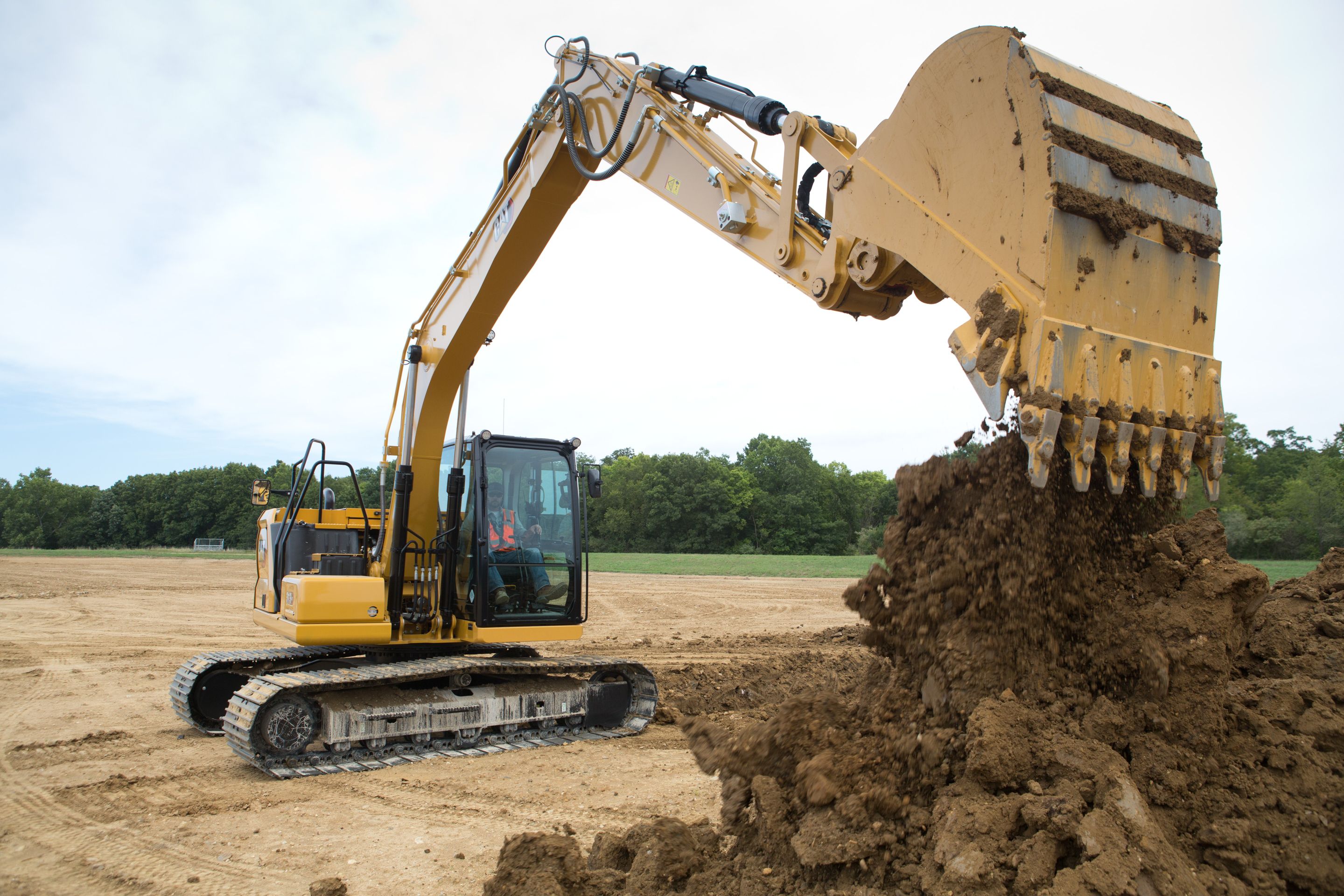

Sign In
Welcome! Sign In to personalize your Cat.com experience
If you already have an existing account with another Cat App, you can use the same account to sign in here
Register Now
One Account. All of Cat.
Your Caterpillar account is the single account you use to log in to select services and applications we offer. Shop for parts and machines online, manage your fleet, go mobile, and more.
Account Information
Site Settings
Security
Author: Small Business Expert | March 28, 2023 | Topic: Used Equipment

When it comes to heavy construction equipment, it’s important to match the size to your project. Each class of earthmover has a design tailored to a specific scope of work, providing you with the power you need to dig, haul, load and move whatever materials you’re working with, wherever you’re working.
When choosing an excavator for your project, it’s vital to know the different size categories and what they’re suited for. Considering what you need in an excavator lets you make a wise investment with the best long-term value for your business. Our excavator selection guide will help you compare the different sizes of excavators, helping you to be confident in your choice.
Excavator Size Categories
Like many heavy-duty machines, excavators come in four categories of sizes. Each category differs in its:
- Capacity
- Performance
- Design
- Maneuverability
- Ease of transport and storage
The excavator size comparison below will examine the different types of excavators.
Mini Excavators
The smallest in excavator sizes, mini excavators offer an extremely narrow footprint and user-friendly controls. Mini excavators are the ideal selection for residential construction and landscaping projects. Their compact design makes them safe to use in narrow spaces without the worry of any tail swing contacting surrounding structures.

The mini excavator category has the following range of specs:
- Dig depth between 5.5 and 17 feet
- Operating weight between 1 and 10 metric tons
- Horsepower between 13 and 70
Designed for high efficiency and speedy work in tight spaces, mini excavators are surprisingly versatile in various scenarios. With the right attachments, mini excavators are suitable for projects from demolition and lot clearing to trailblazing and tree planting. Their compact frame also makes them easy to transport on a standard flat deck trailer, offering project-ready convenience.
Small Excavators
Compatible with a range of standard work tools, small excavators are a preferred choice in multi-residential or commercial construction. Small excavators often perform the same applications as mini excavators but offer greater digging depth, reach and lifting power. Small excavators are also light enough to pose minimal risk to compacting soft or finished soil.
In the small excavator category, you’ll find the following specs:
- Dig depth between 19 and 21 feet
- Operating weight between 30,000 and 40,000 pounds
- Horsepower between 73 and 130
Like mini excavators, small excavators are also relatively easy to transport. A class 1 or 2 truck with a standard flatbed trailer can tow your small excavator easily. Before making an investment, however, check with your DMV to confirm local requirements.
Medium Excavators
Medium-sized excavators make up the majority of excavators found on work sites. Their high performance, larger load capacity and deeper dig depth make them suitable for various heavy-duty industries. You’ll find medium excavators put to use in projects like utilities, commercial landscaping and road and bridge construction.
Medium excavators offer the following spec ranges:
- Dig depth between 22 and 24 feet
- Operating weight between 48,000 and 77,000 pounds
- Horsepower between 146 and 275
Different manufacturers offer various designs, some of which have more tail swing than others. Some models have designs that minimize or eliminate turn radius, making them more suitable for narrower sites.
Large Excavators
When you need power and performance, large excavators are there to provide it with the lift, reach and dig depth you need for your heavy-duty projects. Whether you’re taking on major commercial construction, large-scale demolition or civil infrastructure projects, large-scale excavators are necessary to get the job done.
With large excavators, you can find the following spec offerings:
- Dig depth between 23 and 32 feet
- Operating weight between 80,000 and 207,000 pounds
- Horsepower between 273 and 542
As excavators increase in size, they sacrifice maneuverability, and a large excavator will be more of a challenge to navigate over uneven terrain. While large excavators’ weight and size also present a challenge for transport and storage, they offer the power you need for severe-duty projects.
Size Is Right for Your Job?">Which Excavator Size Is Right for Your Job?
With a general understanding of what distinguishes each excavator size, you can consider which one best suits the kind of jobs you specialize in. Following an excavator size guide can help you purchase an excavator that matches your needs.
The following are the top factors to consider when choosing the right size excavator.
1. Project Needs
When considering how to choose the right excavator size, you should think in terms of what type of project you typically take on. Do you most often take on small, frequent jobs like landscaping or do you tackle large long-term projects like road construction or forestry? Consider what has and hasn’t worked on past projects with your excavators or other construction equipment.
It’s also important to consider the hydraulics requirements, which can significantly improve your productivity when appropriately matched to your project tasks. Choose an excavator with the right hydraulic systems that can provide the power you need for a full day’s work of digging, hauling or lifting. If you need highly efficient and productive machinery, be sure to match the excavator’s hydraulics to your requirements.
Finally, consider the type of attachments your project requires and whether they’re compatible with the excavator you have in mind. Thanks to hydraulic coupling, the list of excavator-compatible attachments has significantly expanded.
2. Work Site Factors
Consider the following about the parameters of your worksite:
- Available space and types of structures needing to maneuver around
- Nearby obstacles or hazards that larger excavators may impact with longer reach
- Distance traveled across the worksite if needing to dig in multiple locations
When it comes to worksite conditions, will you need the power of large excavators or the maneuverability of smaller machines? You can often find a sweet spot that gives you the performance you need with enough maneuverability to perform your work efficiently.
When it comes to worksite terrain, consider:
- Ground type and whether it’s soft, already compacted or finished soil
- Terrain evenness vs. ruggedness
- Ground sloping vs. a site that’s flat and level
When you’re shopping for a used excavator, advise your dealer of your typical worksite conditions so they can make an informed and helpful recommendation based on your needs.
3. Digging Depth
Since digging is an excavator’s primary function, the machine’s digging power is a huge part of how to choose the right-sized excavator. An excavator’s dig depth is based on its boom length and refers to how deep below the surface the machine can dig.
The digging depth you’ll need depends on the types of projects you’re involved in. Whether you’re digging trenches to install utility pipes or carving out a foundation for a high-rise building, you’ll need an excavator equal to the task. Choose an excavator size that can accommodate your typical projects and consider relying on excavator rentals to fill in the gaps on any outlying projects.

Should you find that your digging needs change, you can also upgrade your excavator with a longer boom in the future to achieve the digging depth you need.
4. Boom Reach
Boom reach is closely related to your digging depth requirements and another essential factor when choosing the right-sized excavator. Boom reach refers to how far out in front of the machine the excavator can dig while stationary.
The reach you require depends on the type of project and the terrain. For example, demolition projects may need you to reach farther in front, so having a longer reach will be more convenient. However, the closer you can dig to the machine, the shorter your cycle times, so a shorter reach may be able to improve your productivity. Choose an excavator with the shortest possible reach for your project needs while maintaining accessibility.
5. Lifting Capacity
An excavator’s lifting capacity refers to the total weight of material an excavator can lift at once. Because lifting and hauling are the other primary functions of an excavator, choosing a machine with sufficient lift capacity is critical to maintaining high productivity.
When choosing an excavator based on its lift capacity, consider the following:
- How heavy are the materials are that you work with?
- How frequently do you lift and haul your materials?
- Do you have any future projects that may involve other types of material?
Your answers to these questions will help you determine how much power you need behind your excavator’s lift function. The larger the excavator, the more capable it is of handling heavy loads.
6. Transportation and Storage
Transportation and storage are factors to consider beyond the excavator’s capabilities. Size is the biggest determinant of how you’ll be able to transport your excavator and where you’ll store it. The larger the excavator, the more you’ll need to plan your logistics. Small and mini excavators are simpler to transport using a flatbed trailer and you can store them at home if you have the available yard space.
Bigger excavators require larger trailers and heavier-duty trucks capable of safely towing the equipment. Owners of medium-sized and larger excavators often store their machines in a heated storage facility during the winter. If you have a large enough property, you can also construct a shelter to protect your excavator from the elements.
If you plan to frequently transport excavators between job sites, you’ll likely want the smallest size possible for your project. However, if you typically work on one longer-term project at a time, you can keep your larger excavators on-site and reduce transport frequency.
Types of Common Excavator Attachments
When choosing the right-sized excavator for your project needs, it’s equally important to think about the right implements for the job. With so many specialty attachments available for excavators, you’ll always have the right tools for the job no matter what your project demands.
The most common types of excavator attachments are:
- Buckets: From standard to rock to clean-up buckets, there are several different bucket configurations designed for different aspects of excavation work.
- Augers: Use an auger attachment for heavy-duty drilling and precision hole digging. Augers drill deep, even holes into hard ground for footings, tree plantings and fence posts.
- Thumbs: Hydraulic thumbs are appendages you can add to your bucket that make handling loose material, branches and debris easier. Gain better control over your material and improve your efficiency with thumb attachments.
- Hammers: When you need to break up tightly compacted earth or concrete, use a hammer attachment. Hammers deliver a powerful impact to your working surface, making them useful in mining, quarry and demolition projects.
- Rippers: Acting as a powerful claw, a ripper attachment punctures hard surfaces like frozen ground or rock. A ripper can offer more precision and efficiency when digging in highly compacted surfaces.
- Grapples: If you frequently handle and lift irregular materials, grapples will provide you with better control. Particular material types use different configurations, including forestry, trash and demolition grapples.
- Couplers: When you need to change out excavator attachments efficiently, use a coupler to swap between tools. Couplers bypass the need for manually changing out attachments, allowing you to maintain high productivity.
Choose Cat Used for high-quality excavator attachments. Browse our inventory of construction and landscaping work tools for excavators.
Why Choose a Cat® Excavator?
Along with four categories of Cat® excavator sizes, Caterpillar also offers performance, reliability, financing and support, giving you long-term value on your investment in used equipment.
Discover the Cat Advantage you get when you purchase a Cat Used excavator:
- Certified Used: Cat excavators deemed Certified Used have met certain conditions under a robust assessment process. When you buy a Cat Certified Used excavator, you’ll know it’s a low-hour machine that has passed a rigorous inspection and been maintained using genuine Cat parts.
- Reliability and performance: Cat excavators are designed and built for reliability and performance, ensuring confidence in your return on investment as an owner.
- Customer Value Agreements: One of the best ways to ensure proper maintenance and smooth operation for your used excavator is to choose a Cat Customer Value Agreement (CVA). When you buy a Cat Used or Cat Certified Used machine, your CVA will provide you with the right parts - delivered on schedule as you need them. Depending on your dealer and your choice of a Cat Used CVA or a Cat Certified CVA, you can track machine insights on your phone and receive flexible service options.
Discover more about the peace of mind the Cat Advantage offers Certified Used excavator owners. Contact your local Cat dealer to learn more about a CVA for your Cat Used excavator.
Browse Cat Used for Reliable, High-Performing Used Excavators
Choose Cat Used to search for reliable and high-performing used excavators. Browse various used Cat excavator sizes, as well as different sizes from other leading manufacturers like John Deere, JCB and Komatsu.
Shop used excavators online and find the right model, size and price point to fit your needs. For expert help selecting the right size excavator or any other used machine, visit a trusted Cat dealer near you.



